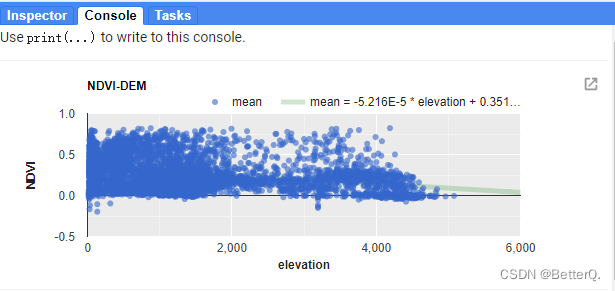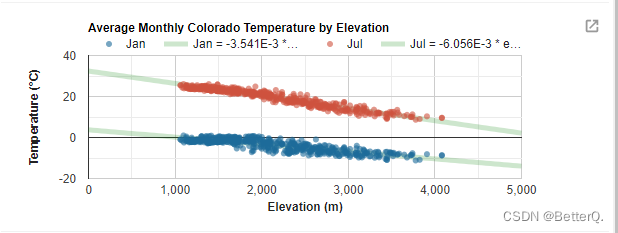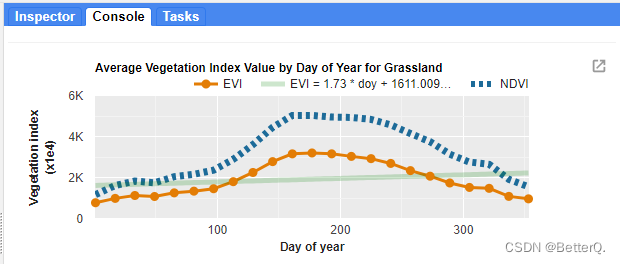|
最近使用Google Earth Engine(GEE)分析了一下高程和NDVI的相关性,并绘制二者的散点图,计算其决定系数。 计算时主要用到了GEE中的图表 ui.Chart.image.byRegion(),将研究区域内的高程和NDVI的散点图先绘制出来,再添加趋势线,计算决定系数,就可以知道二者之间的相关性有多高。 NDVI-高程散点图及决定系数计算实现代码如下:
//研究区域,可自己绘制或导入
var roi = /* color: #d63000 */ee.Geometry.Polygon(
[[[104.34385678174718, 27.233899188878446],
[114.80284115674718, 28.477166904461537],
[117.52745053174718, 34.61402019968164],
[111.99034115674718, 40.99546927185892],
[95.11534115674718, 37.87379212761336]]]);
//导入 DEM
var DEM=ee.Image("CGIAR/SRTM90_V4").reproject('SR-ORG:6974',null,500);
//从DEM中抽取样本点,这里选取500个
var rroi = DEM.sample(
{region: roi, scale: 30, numPixels: 500, geometries: true});
//导入NDVI数据
var ndvi=ee.ImageCollection('MODIS/006/MOD13A1')
.filter(ee.Filter.date('2020-01-01', '2020-02-01'))
.first()
.multiply(0.0001);
// 设置图表属性,包括样式颜色等
var chartStyle = {
title: 'NDVI-DEM',
hAxis: {
title: 'elevation',
titleTextStyle: {italic: false, bold: true},
gridlines: {color: 'FFFFFF'}
},
vAxis: {
title: 'NDVI',
titleTextStyle: {italic: false, bold: true},
gridlines: {color: 'FFFFFF'},
},
pointSize: 4,
dataOpacity: 0.6,
chartArea: {backgroundColor: 'EBEBEB'},
//添加趋势线
trendlines: {
0: { // add a trend line to the 1st series
type: 'polynomial', // or 'polynomial', 'exponential'
color: 'green',
showR2:'true', //show R2 cofficient
lineWidth: 5,
opacity: 0.2,
visibleInLegend: true,
}
}
};
//绘制散点图
var charten=ui.Chart.image.byRegion({
image:ndvi.select('NDVI'),
regions:rroi,
reducer:ee.Reducer.mean(),
scale:500,
xProperty: 'elevation'
});
charten.setChartType('ScatterChart').setOptions(chartStyle);
print(charten)
结果如图所示:  . . . . 这里还做了温度和高程之间的关系,实现代码: . . . . 这里还做了温度和高程之间的关系,实现代码:
// Load SRTM elevation data.
var elev = ee.Image('CGIAR/SRTM90_V4').select('elevation');
// Subset Colorado from the TIGER States feature collection.
var colorado = ee.FeatureCollection('TIGER/2018/States')
.filter(ee.Filter.eq('NAME', 'Colorado'));
// Draw a random sample of elevation points from within Colorado.
var samp = elev.sample(
{region: colorado, scale: 30, numPixels: 500, geometries: true});
// Load PRISM climate normals image collection; convert images to bands.
var normClim = ee.ImageCollection('OREGONSTATE/PRISM/Norm81m').toBands();
// Define the chart and print it to the console.
var chartte = ui.Chart.image
.byRegion({
image: normClim.select(['01_tmean', '07_tmean']),
regions: samp,
reducer: ee.Reducer.mean(),
scale: 500,
xProperty: 'elevation'
})
.setSeriesNames(['Jan', 'Jul'])
.setChartType('ScatterChart')
.setOptions({
title: 'Average Monthly Colorado Temperature by Elevation',
hAxis: {
title: 'Elevation (m)',
titleTextStyle: {italic: false, bold: true}
},
vAxis: {
title: 'Temperature (°C)',
titleTextStyle: {italic: false, bold: true}
},
pointSize: 4,
dataOpacity: 0.6,
colors: ['1d6b99', 'cf513e'],
trendlines: {
0: { // add a trend line to the 1st series
type: 'linear', // or 'polynomial', 'exponential'
color: 'green',
showR2:'true', //R2 cofficient
lineWidth: 5,
opacity: 0.2,
visibleInLegend: true,
},
1: { // add a trend line to the 1st series
type: 'linear', // or 'polynomial', 'exponential'
color: 'green',
showR2:'true', //R2 cofficient
lineWidth: 5,
opacity: 0.2,
visibleInLegend: true,
}
}});
print(chartte);
. 结果如图:  . . . . 以及绘制植被指数随时间变化的曲线图: . . . . 以及绘制植被指数随时间变化的曲线图:
// Import the example feature collection and subset the glassland feature.
var grassland = ee.FeatureCollection('projects/google/charts_feature_example')
.filter(ee.Filter.eq('label', 'Grassland'));
// Load MODIS vegetation indices data and subset a decade of images.
var vegIndices = ee.ImageCollection('MODIS/006/MOD13A1')
.filter(ee.Filter.date('2010-01-01', '2020-01-01'))
.select(['NDVI', 'EVI']);
// Set chart style properties.
var chartStyle = {
title: 'Average Vegetation Index Value by Day of Year for Grassland',
hAxis: {
title: 'Day of year',
titleTextStyle: {italic: false, bold: true},
gridlines: {color: 'FFFFFF'}
},
vAxis: {
title: 'Vegetation index (x1e4)',
titleTextStyle: {italic: false, bold: true},
gridlines: {color: 'FFFFFF'},
format: 'short',
baselineColor: 'FFFFFF'
},
series: {
0: {lineWidth: 3, color: 'E37D05', pointSize: 7},
1: {lineWidth: 7, color: '1D6B99', lineDashStyle: [4, 4]}
},
chartArea: {backgroundColor: 'EBEBEB'},
trendlines: {
0: { // add a trend line to the 1st series
type: 'linear', // or 'polynomial', 'exponential'
color: 'green',
showR2:'true',
lineWidth: 5,
opacity: 0.2,
visibleInLegend: true,
}
}
};
// Define the chart.
var chart =
ui.Chart.image
.doySeries({
imageCollection: vegIndices,
region: grassland,
regionReducer: ee.Reducer.mean(),
scale: 500,
yearReducer: ee.Reducer.mean(),
startDay: 1,
endDay: 365
})
.setSeriesNames(['EVI', 'NDVI']);
// Apply custom style properties to the chart.
chart.setOptions(chartStyle);
// Print the chart to the console.
print(chart);

|
 . . . . 这里还做了温度和高程之间的关系,实现代码:
. . . . 这里还做了温度和高程之间的关系,实现代码: . . . . 以及绘制植被指数随时间变化的曲线图:
. . . . 以及绘制植被指数随时间变化的曲线图: